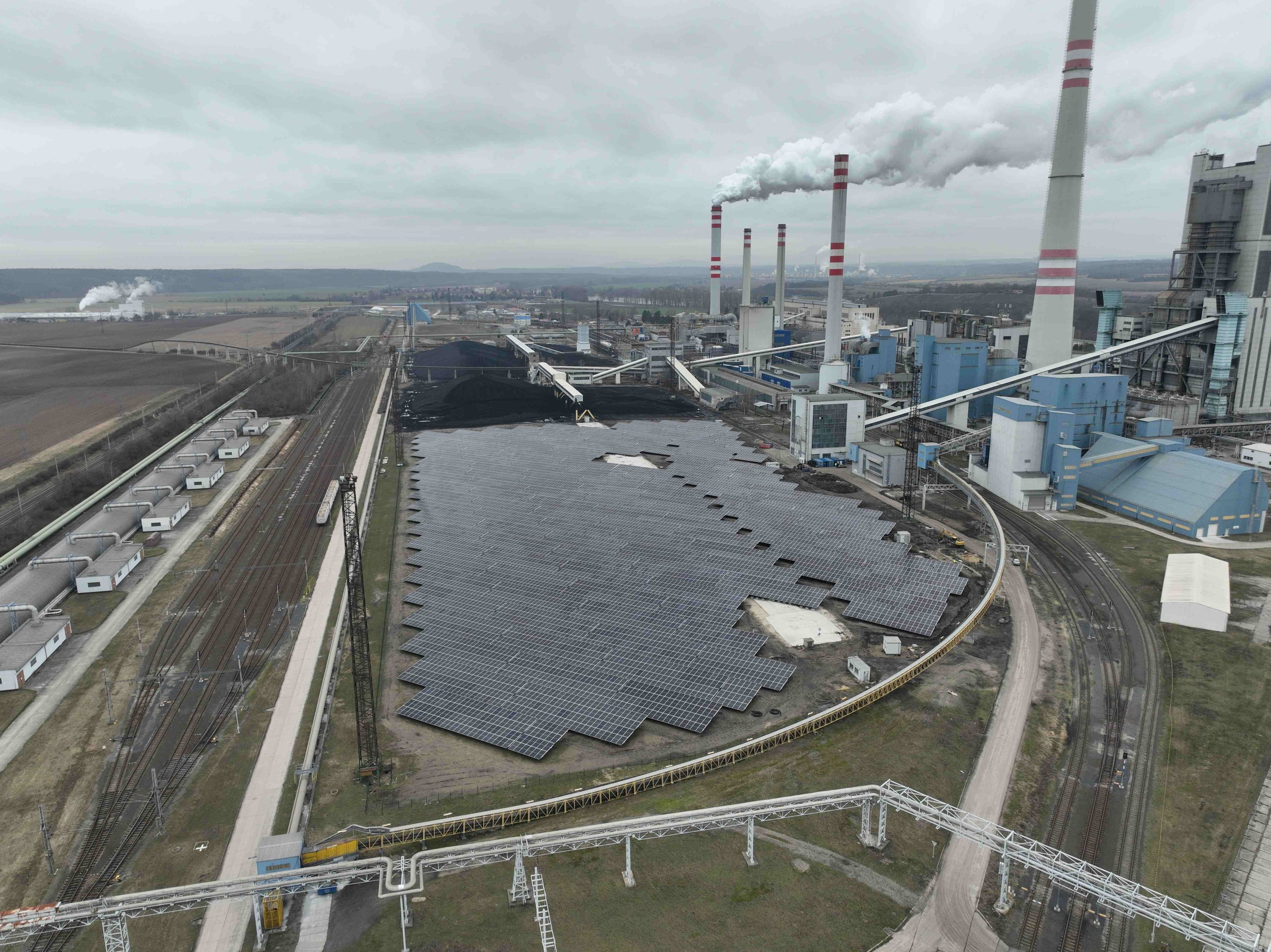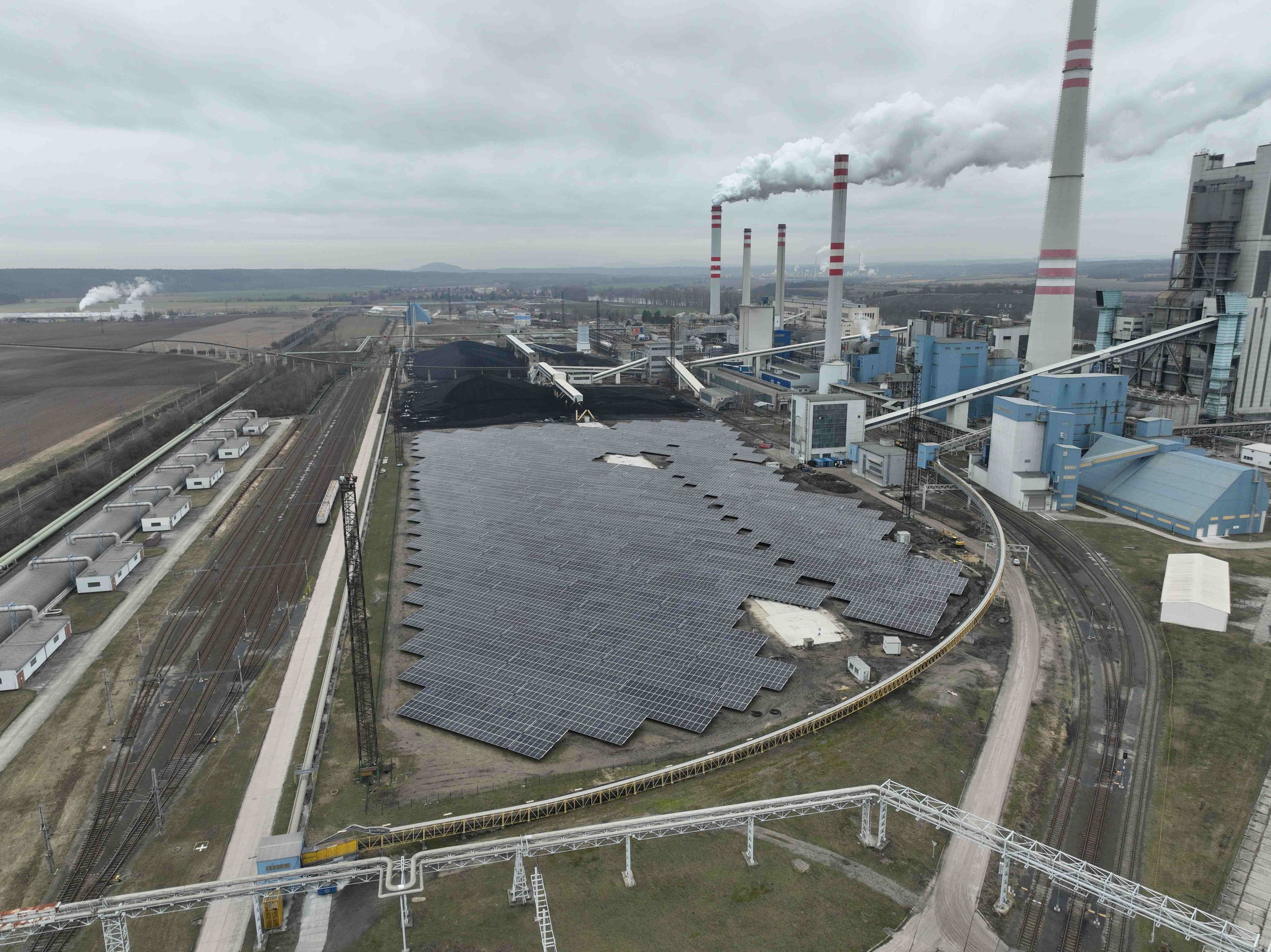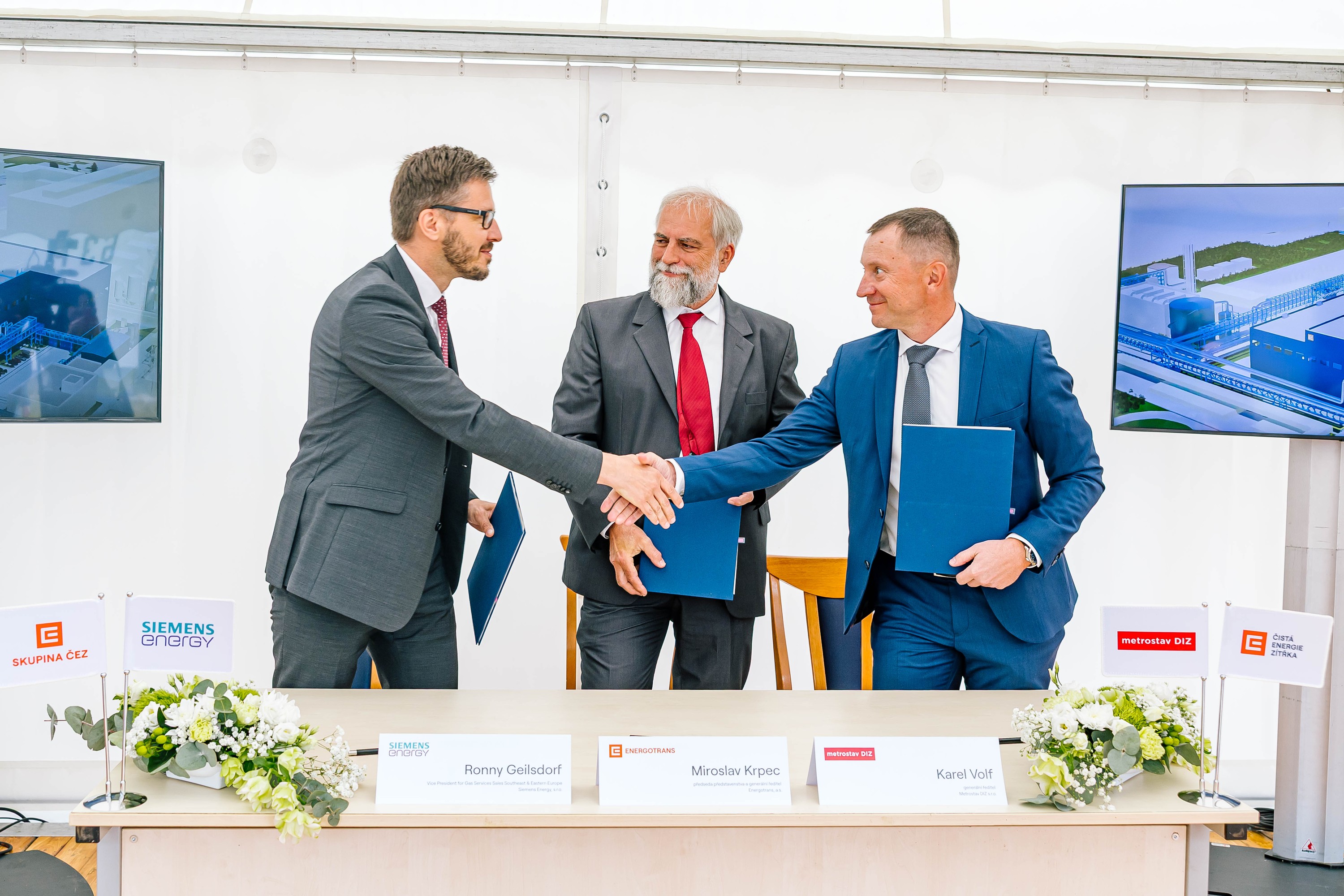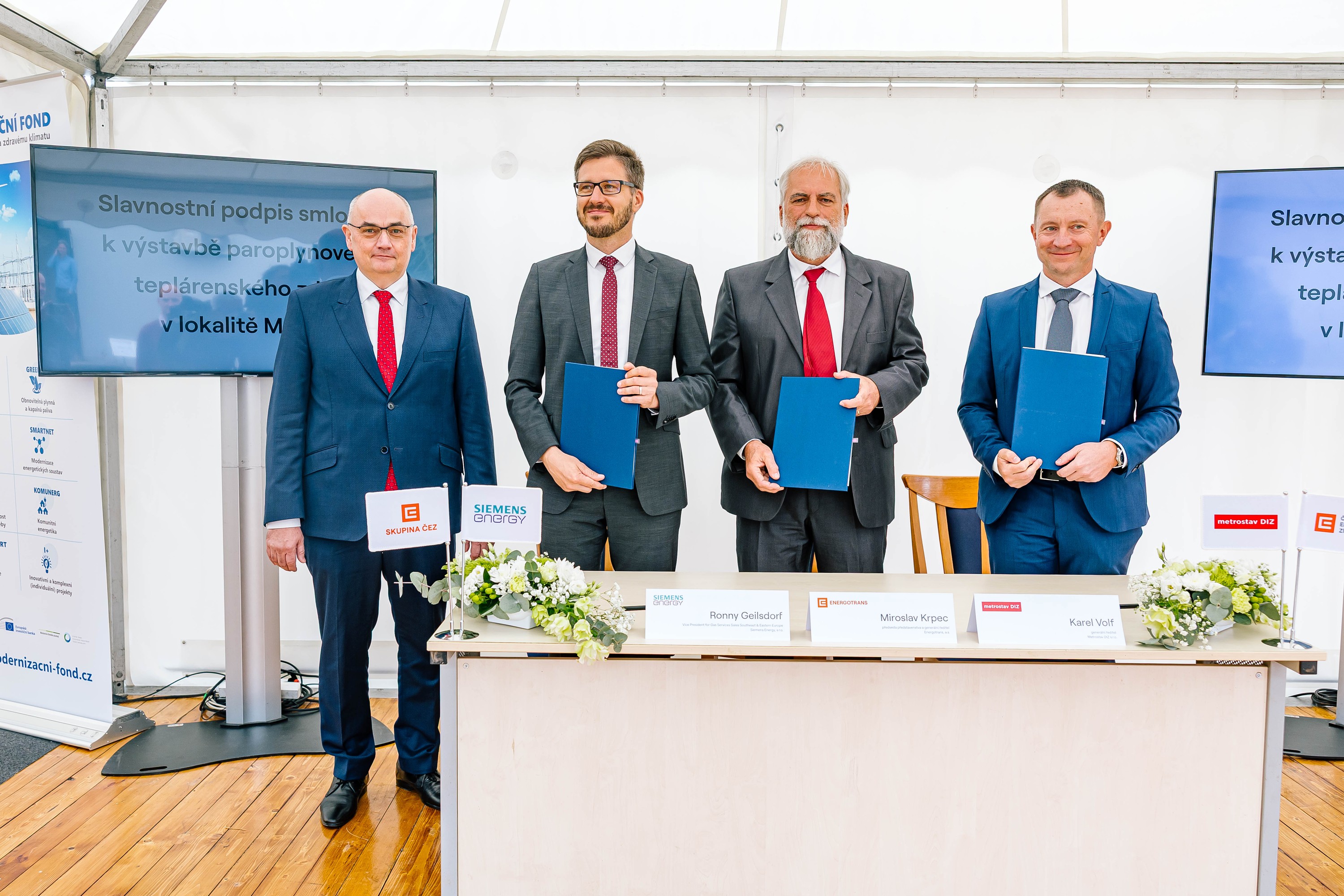The country’s largest steam-gas heat source to be built at Mělník
ČEZ Group continues to decarbonise the Czech heat generation business: by 2029, it will replace the first part of coal generation at the Mělník power plant with a low-emission steam-gas source. Representatives of Energotrans and the contractor – a consortium of Metrostav DIZ and Siemens Energy – signed an agreement for a new heat source for Prague.

The current sources in the Mělník locale – the largest heat producer in the country – will undergo a major transformation by 2030. This will involve the decommissioning of old facilities that will be replaced with new, modern and environmentally friendly sources. By 2030, Mělník will thus completely phase out power and heat generation based on coal.
“The Mělník power plant is a major point on the energy map of the Czech Republic, providing both power generation and a supply of heat. Following a comprehensive transformation, coal will be replaced with steam-gas sources and a waste-to-energy facility, supplemented with capacity in a gas-fired boiler room and electric boilers. The new technologies used at the site will also include a photovoltaic power plant, and power accumulation projects are also in the pipeline. Generally speaking, we want to use the infrastructure in coal sites for a gradual transition to low-emission and zero-emission sources,” says Jan Kalina, Board Member and head of the Renewable and Conventional Energy Division.
Preparations for the construction of the first steam-gas source have already commenced, with the demolition of existing buildings and preparations of the construction site. The facility is scheduled to be commissioned in 2029. The new sources with a power capacity of 266 MWe and heat capacity of 183 MWt are expected to generate nearly 730 GWh of electricity every year, and to supply up to 2 PJ of heat per year, thus accounting for approximately 30% of aggregate heat supply from the Mělník site. The project, involving a consortium of Metrostav DIZ and Siemens Energy as the contractors, will also include a contract for the servicing and maintenance of gas turbines.
“The implementation of the project will ensure supply of heat for nearly one-half of Prague, or, more precisely, nearly the entire right bank of the Moldau River, as well as Mělník itself, and Neratovice. Overall, it includes some 230,000 households, as well as schools, government offices, and hospitals. Our goal is to guarantee reliable supply of heat for decades to come,” adds Miroslav Krpec, CEO of Energotrans from ČEZ Group.
The project is co-financed from the EU system for emissions trading, through the Modernisation Fund. Energotrans has received 7.26 billion crowns as investment support for its implementation, which accounts for more than 50% of the total expenses, as well as operating aid in the form of an electricity auction bonus, for 15 years after the commissioning of the source.
Total investments at the Mělník locale will reach more than 50 billion crowns. As many as three steam-gas sources will be gradually built and commissioned, with a total electric capacity of nearly 1200 MWe. All new steam-based sources will also be prepared for future use of hydrogen. In late 2027 or early 2028, ČEZ plans to start pilot operation of a waste-to-energy facility (ZEVO). The first construction work should start this summer, including, in particular, the setting up of construction-site facilities for the contractor and demolition of old buildings to free up space for the new building. Last year, a photovoltaic plant with an installed capacity of 7.3 MWp was commissioned at a former coal store site. Other supplementary technologies planned as part of the transformation of the locale include a gas boiler room, electric boilers, heat accumulation, and a battery system for storing electricity.
ČEZ Group has been preparing for the phasing out of coal in the Czech heat generation business for some time, preparing and planning new low-emission heat generation plants worth tens of billions of crowns that will operate primarily on biomass and natural gas. At the same time, ČEZ stives to retain a central heat supply system wherever conditions are favourable and wherever it can reach an agreement with partners at the municipal and regional level. The benefits that modernisation of the heating system will bring to customers include stable, secure, and environmentally friendly supplies for decades to come, a positive impact on air quality, and minimal strain on municipal budgets.
ČEZ is already building new, modern heat-generation plants in the Ústí nad Labem Region, in Prunéřov, Tušimice, and Ústí nad Labem, and also in the Moravian-Silesian Region, in Dětmarovice. The solution includes use of heat from nuclear power plants, an example of which is the functioning connection of the Temelín nuclear power plant with České Budějovice.
Did you know…? Some interesting facts about the Mělník site:
- The Mělník power plant is 13 kilometres below the confluence of the Elbe and Moldau Rivers.
- The heat consumer furthest from the Energotrans heaters is 74.5 kilometres away.
- Water for Prague is carried via a pipeline with a diameter of 1.2 meters over a distance of more than 34 km, with a pressure of up to 2.5 MPa.
- The Mělník – Prague feeder crosses the Moldau River twice and the railway four times, using steel truss bridges.
- A small hydroelectric power plant operates on the grounds of the Mělník power plant, with an installed capacity of 490 kW, which converts into electricity the current of residual cooling water from the Mělník operations.
- Heat is supplied to Prague via a unique heat feeder. Thermal energy is carried using compressed hot water, with temperatures fluctuating between 90 and 140 °C, depending on the season. On the consumer side (in Prague or in Neratovice), the water is cooled (it passes on heat) and returns at temperatures ranging from 60 to 70 °
- Water in the heat feeder pipeline travels at a speed of over two metres per second.
- Hot water travels to Prague in 8 hours on average, cooling by approximately 1°C during that time; losses during such supply usually do not exceed 4% (depending on the season).
- Heat generation and supply is continuous throughout the year, 24 hours per day, with the exception of a single week in the summer, when planned feeder maintenance takes place.
Barbora Peterová, mluvčí ČEZ
- ČEZ’s renewable sources to be managed from a single location
- Further emissions reduction: CEZ Group releases its first Sustainability Report aligned with European CSRD Directive
- Lithium Mining and Processing in Ústí nad Labem Region Included Among European Union’s Strategic Projects
- Inven Capital invests in Vytal: a German company that reduces the environmental impact in gastronomy via high-tech platform and smart packaging


